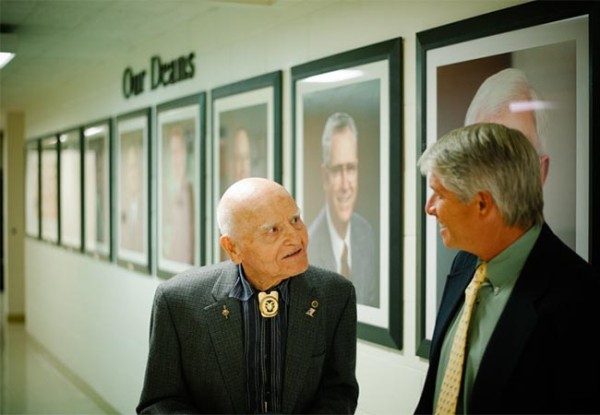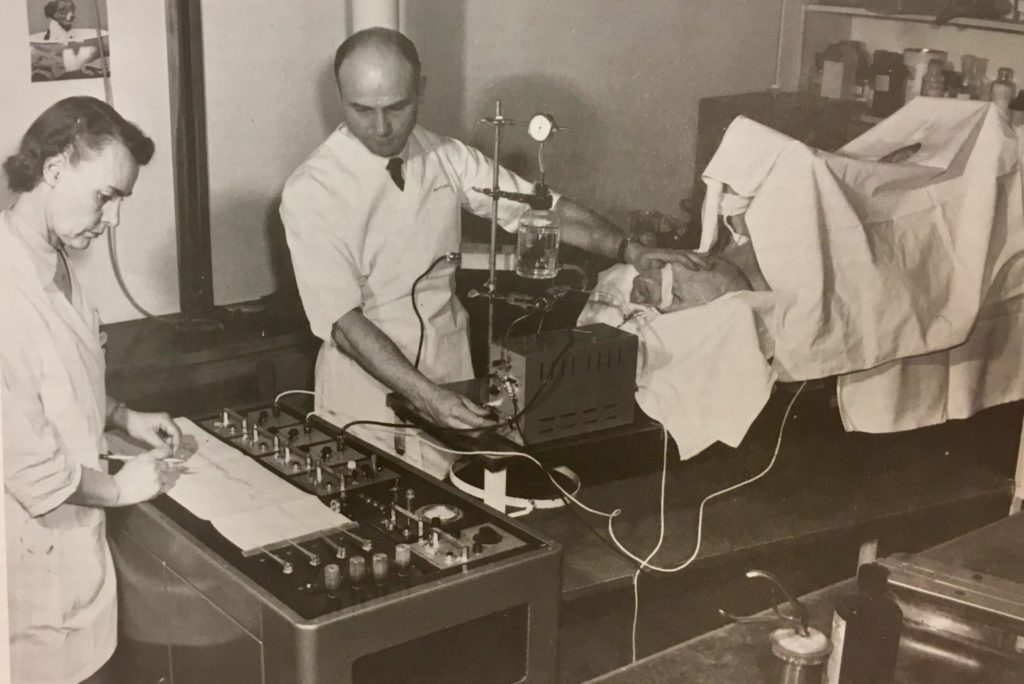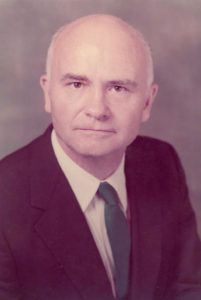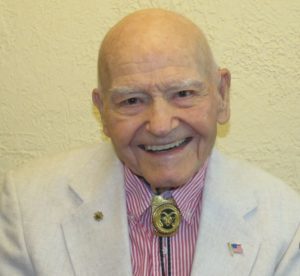
Interview by Claire Tucker, College of Veterinary Medicine and Biomedical Sciences Office of Advancement
Dr. Nicholas H. Booth, Dean of the College of Veterinary Medicine and Biomedical Sciences, 1966-1971
D.V.M. Michigan State University, ’47; M.S., Physiology and Biophysics, Colorado A&M College ’51; Ph.D., University of Colorado, ’59
Dr. Nicholas H. Booth led the College of Veterinary Medicine and Biomedical Sciences through a time of intense change on the CSU campus, within the college, and in society at large. “Booth handled these challenges with phenomenal personal dedication, customarily putting in 16 to 18-hour work days… Honest, warm and imbued with a sense of compassion for both faculty and students, he ‘wanted to be totally involved in order to make fair decisions,'” according to the history of the college, “Chiron’s Time.”
In 2010, the college named Booth Road, which is to the east of the James L. Voss Veterinary Teaching Hospital, for him. Booth will be honored as the college’s 2017 Distinguished Alumnus for his significant contributions to his community, profession, and the University, on Thursday, Oct. 12 at the Distinguished Alumni Awards Dinner during CSU’s Homecoming and Family Weekend.
An Early Start
“I grew up on a dairy near the town of Hannibal, Mo., the birthplace of Mark Twain. As a child, I helped with the dairy chores, rising at 4 a.m. to deliver the glass bottles to houses. Between the deliveries and my schooling, I was a busy young man. Although Hannibal High School had a great football team, I was only able to go to one game! On the dairy, we often had a veterinarian out to visit our 50 girls. I would follow the veterinarian around like a sheepdog to his flock, observing all of his movements. After a number of these visits (at about the age of 13), I realized I wanted to be a veterinarian too.
“I graduated from high school in 1941, the same year as the attacks on Pearl Harbor. Soon after starting at the University of Missouri, I volunteered to serve in the U.S. Navy as a corpsman in World War II. I received an Honorable Discharge including a Good Conduct Medal. I then completed my studies at Michigan State University, where I received my D.V.M. degree.”
Making My Way West
“I returned to Missouri for just one year to work in a beef cattle, dairy cattle, and swine practice. But I wanted to return to academics to continue my education, starting a master’s program in physiology in 1948 at Colorado A&M University. At that time, graduate students could also teach so I was also an assistant professor in my department. These early years helped to foster my interests in teaching and in the institution of Colorado A&M.
During my sabbatical leave to work on my Ph.D. at the University of Colorado Medical School, I became department head of Physiology and Biophysics in 1956. I remember getting the offer so clearly. The Dean of the college at the time, Dr. Floyd Cross, came into my office on a Saturday morning. His question surprised me – I had only been in the department for eight years – but I agreed to accept the position.”

Leading the Rams

“After 10 years as department head, I moved into the position of dean. As dean of the college, one of my first actions was to change the name of the college, from the College of Veterinary Medicine to the College of Veterinary Medicine and Biomedical Sciences. By that time, there was an immense amount of work happening that expanded well beyond the boundaries of veterinary medicine. I wanted a name that reflected that innovation and diversity.
“During the late 1960’s, the college experienced booming enrollment, with students coming for the well-known veterinary education as well as programs in the biomedical sciences. To match this expanding number of students, I knew we would quickly need new facilities. Through many trips to Washington D.C., I helped to forge partnerships with the National Institutes of Health and the National Science Foundation to provide matching funds for the new facilities. Eventually these funds were used to build the James L. Voss Veterinary Teaching Hospital among many others that are still used by the college to this day.”
My Next Frontiers
“Leaving Colorado State University was one of the most difficult decisions I made in my career. I came to the area with my wife and raised my three children in Fort Collins. I left to take a position as the Director of Veterinary Medical Research for the Food and Drug Administration. I worked on a variety of projects, but I am especially proud of some work we did on the levels of DDT in cat food. We helped realize that 5 parts per million (ppm) was an acceptable level in cats. It was a compelling calculation that eventually helped lower the human safety level to 5 ppm as well. A true One Health project!
“A few years later, I took a teaching and research position at the University of Georgia with appointments in the College of Veterinary Medicine and the College of Pharmacy. Some of my early work was focused on investigating fescue toxicity, a condition common in cattle in the Southeast when they grazed on moldy pasture. I spent the rest of my academic career at the University of Georgia, continuing to relish the opportunities I had to teach, research and support another great institution.”
A Legacy of Mentorship
“Every time I return to Fort Collins, I try to meet with the current dean of CVMBS. In fact, I’ve met every dean, except the very first, Dr. George Glover. I received excellent mentorship from the men that went before me and I hope I have provided some of that guidance to those that have come after. The current dean, Dr. Mark Stetter, is an outstanding and dynamic individual. I think his brilliant insight and specialized knowledge is important for the future of the college.”
Advice for the Next Generation

“Veterinary students coming into the profession are bright, interesting, and motivated. I do have one piece of advice for them. When you earn a D.V.M. degree, do not forget that Latin origin of the word doctor is docere, which means ‘to teach.'” It means that you should not conceal information from clients and teach them what is involved in the special care and treatment of their animals.
“I see great things for CSU and the college of Veterinary Medicine and Biomedical Sciences in the future. Our world is in great need of good scientists. There are so many problems to solve. I believe we will continue to be pioneers of these answers that advance the welfare of human and animal health. But it is one thing to be well-trained, kind, and caring. It is another to be able to handle matters in a spirit and tone of equanimity. Moreover, I believe the alumni of CSU can meet most challenges of the future with equanimity!”